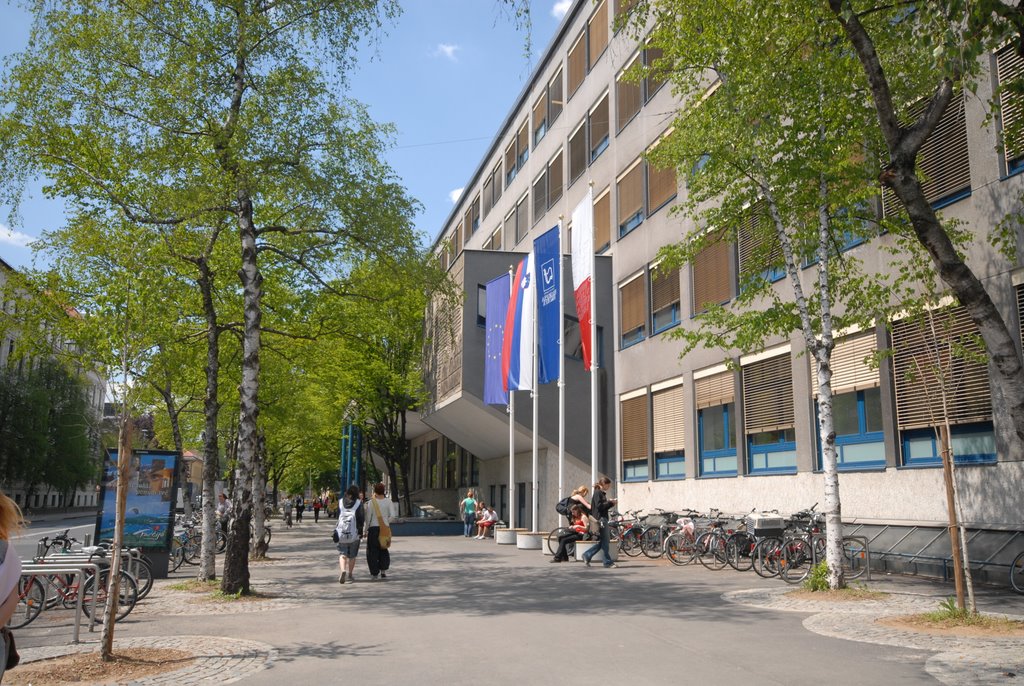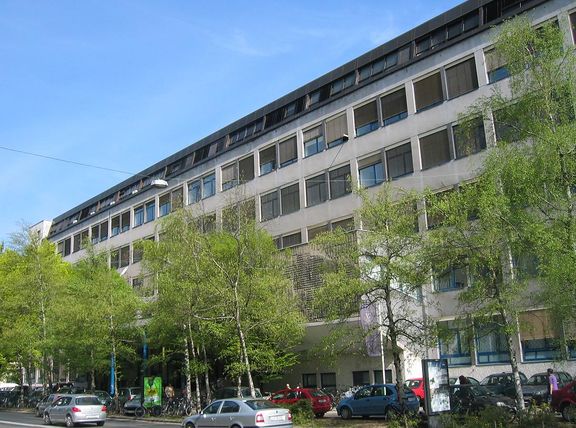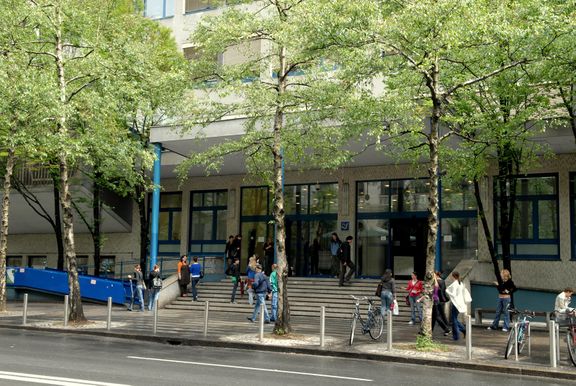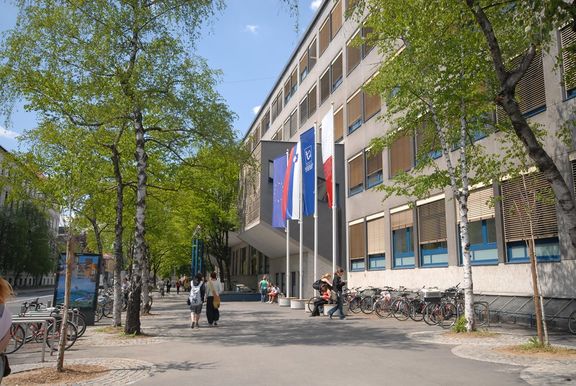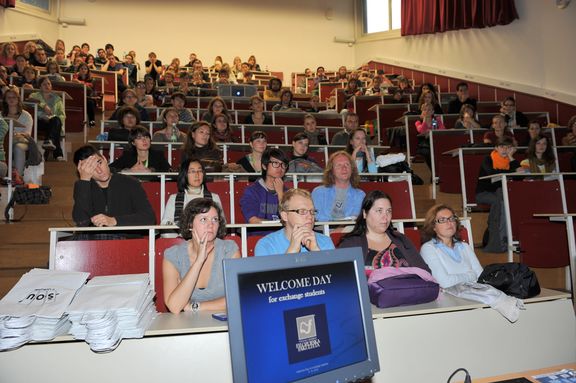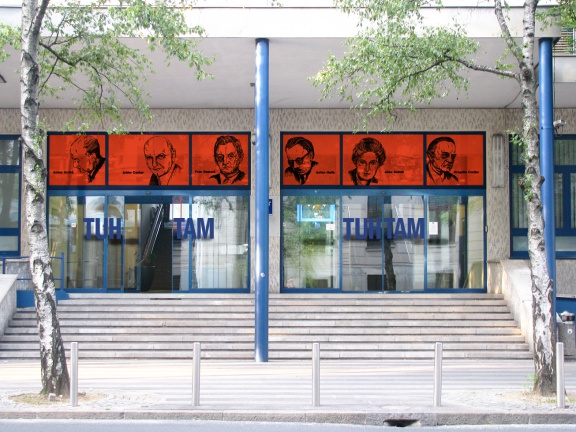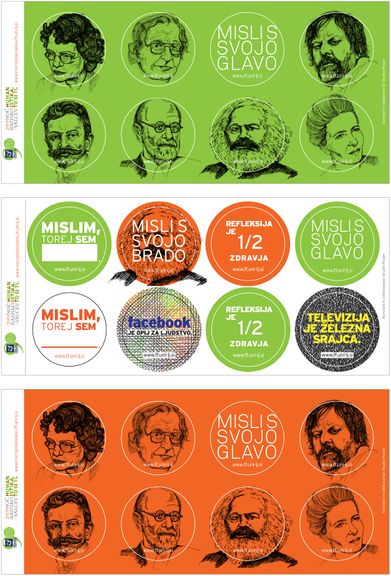Faculty of Arts, University of Ljubljana
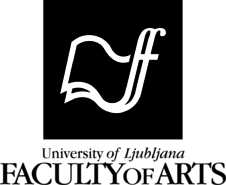
Past events
-
24 Mar 2020
United KingdomLondonUCL SSEES (Masaryk Room)Marta Verginella (Faculty of Arts, University of Ljubljana) gives a lecture entitled From Slovenka to Ženski svet: Slovene Feminism in Trieste between Cosmopolitism and the National Struggle, 1897-1928, in the frame of the UCL SSEES Central European Seminar Series, supported by the Embassy of the Republic of Slovenia in London,
-
6 Dec 2018
United KingdomLondonUCL SSEESWorld Festival of Ivan CankarA lecture Innovation and Social Reality in the Plays of Ivan Cankar by Mateja Pezdirc Bartol (Faculty of Arts, University of Ljubljana), organised in cooperation with the Centre for Slovene as a Second/Foreign Language, supported by the Embassy of the Republic of Slovenia in London,
-
3 Dec 2018
USANew YorkMuseum of Modern ArtA lecture/panel with art historian Beti Žerovc (Faculty of Arts, University of Ljubljana) entitled Learning from Yugoslavia in the frame of the exhibition Toward a Concrete Utopia: Architecture in Yugoslavia, 1948–1980
-
28 Nov 2018
SerbiaBelgradeSava CentreA lecture on Ivan Cankar by Mateja Pezdirc Bartol (Faculty of Arts, University of Ljubljana)
-
to
5 Nov 2018
6 Nov 2018
AustriaViennaInstitute for Slavic Studies of the University of ViennaWorld Festival of Ivan CankarWorld Day of Ivan Cankar, including the screening of Amir Muratović's film Cankar and lectures by Alojzija Zupan Sosič (Faculty of Arts, University of Ljubljana) and Damjan Huber, Mateja Lutar, and Mojca Nidorfer Šiškovič (all Centre for Slovene as a Second and Foreign Language), supported by the Slovenian Culture and Information Centre, Vienna (SKICA) (Embassy of the Republic of Slovenia in Vienna),
-
15 May 2018
AustriaGraz/GradecSteiermärkische LandesbibliothekA book presentation by the writer Jani Virk, co-organised in cooperation with Beletrina Publishing Institute, Slowenischer Lesesaal, Graz, Faculty of Arts, University of Ljubljana and the Centre for Slovene as a Second/Foreign Language,
-
14 Mar 2017
United KingdomLondonUCL School of Slavonic and East European StudiesA literary evening with poet Milan Šelj, organized in cooperation with the Embassy of the Republic of Slovenia in London, Faculty of Arts, University of Ljubljana and the Centre for Slovene as a Second/Foreign Language,
-
to
16 Feb 2017
17 Feb 2017
Bosnia and HerzegovinaSarajevoFaculty of Philosophy, Museum of Literature and Performing ArtsWorld Festival of Slovenian CultureA lecture and literary evening with poet Barbara Korun, organised in cooperation with the Centre for Slovene as a Second/Foreign Language, Faculty of Arts, University of Ljubljana and the Embassy of the Republic of Slovenia in Sarajevo,
-
15 Feb 2017
BelgiumGhentGhent UniversityWorld Festival of Slovenian CultureFraternité and egalité among the nations of former Yugoslavia – a historical overview, a lecture by historian Božo Repe (Faculty of Arts, University of Ljubljana), organised in cooperation with the Centre for Slovene as a Second/Foreign Language,
-
14 Feb 2017
BelgiumBrusselsUniversité libre de BruxellesWorld Festival of Slovenian CultureHistorical development of Central Europe – from Slovene perspective, a lecture by historian Božo Repe (Faculty of Arts, University of Ljubljana), within the , organised in cooperation with the Centre for Slovene as a Second/Foreign Language, Faculty of Arts, University of Ljubljana and the Embassy of the Republic of Slovenia in Brussels,
-
2 Feb 2017
CroatiaZagrebBogdan Ogrizović LibraryOn Renaissance Beauty by Marko Uršič (Faculty of Arts, University of Ljubljana), a book presentation supported by the Embassy of the Republic of Slovenia in Zagreb,
-
6 Dec 2016
AustriaGrazInstitut für Slawistik, University of GrazA lecture on contemporary Slovene drama by Mateja Pezdirc Bartol (Faculty of Arts, University of Ljubljana) in the framework of World Festival of Slovene Culture, organised in cooperation with the Centre for Slovene as a Second/Foreign Language,
-
5 Dec 2016
PolandSosnowiecHerbaciarna MarzenieGolden Boat FestivalA translation workshop for Polish Students of Slovenian Language with Tatjana Jamnik participating, organised by the Polica Dubova Cultural and Artistic Association and Literary Association IA, co-organised by the Centre for Slovene as a Second/Foreign Language/Faculty of Arts, University of Ljubljana,
-
28 Nov 2016
AustriaViennaPiaristengymnasiumJosip Stritar (1836-1923), a festive academy celebrating the 180th anniversary of the birth of the writer with a leacture by Irena Samide (Faculty of Arts, University of Ljubljana) and readings by Nika Sommeregger, Metka Wakounig, and Dominik Urak, organised in cooperation with the Slovenian Culture and Information Centre, Vienna (SKICA), Embassy of the Republic of Slovenia in Vienna,
-
to
5 Nov 2016
7 Nov 2016
SlovakiaKošice, RužomberokGolden Boat FestivalA number of Slovenian writers and translators present their works, presentation of the Slovak edition of Iztok Osojnik’s selected poetry, organised by the Polica Dubova Cultural and Artistic Association, Literary Association IA, and the Blue and White Bird Union, co-organised by the Faculty of Arts, University of Ljubljana and the Centre for Slovene as a Second/Foreign Language, supported by the Embassy of the Republic of Slovenia in Warsaw,
-
18 Oct 2016
Czech RepublicBrnoMístogalerie and Filozofická fakulta MUGolden Boat FestivalReadings by Nina Dragičević, Vesna Lemaić, Tibor Hrs Pandur and Iztok Osojnik, the latter holds a lecture Ecology through poetry of Jure Detela. Literary events organised by the Polica Dubova Cultural and Artistic Association, Literary Association IA, and the Blue and White Bird Union, co-organised by the Faculty of Arts, University of Ljubljana and the Centre for Slovene as a Second/Foreign Language and I.D.I.O.T Group, supported by the Embassy of the Republic of Slovenia in Warsaw,
-
to
11 May 2016
12 May 2016
LithuaniaVilniusFaculty of Philology, Venclovas’ House MuseumA celebration of the 20th anniversary of the Slovenian language at Vilnius University accompanied by a concern by Zoran Predin and lectures by Branka Kalenić Ramšak (Faculty of Arts, University of Ljubljana), Marko Stabej, Mojca Nidorfer Šiškovič and Damjan Huber (Centre for Slovene as a Second/Foreign Language)
-
to
11 Apr 2016
14 Apr 2016
SpainGranadaFaculty of Philosophy and Literature, Faculty of Translation and InterpretingA Slovenian literature translation workshop also with Laura Repovš, lectures by Dr. Marko Juvan (Faculty of Arts, University of Ljubljana) and a screening of Spare Parts, directed by Damjan Kozole (E-motion Film), at the Slovenian Language Week, organised by Slovenian Lectureship at the University of Granada, supported by the Embassy of the Republic of Slovenia in Madrid,
-
5 Apr 2016
PolandKatowiceStrefa CentralnaAbout Coffee Over Coffee, a talk with ethnologist and anthropologist Božidar Jezernik, organised in cooperation with the Faculty of Arts, University of Ljubljana and the Centre for Slovene as a Second/Foreign Language,
-
1 Mar 2016
United KingdomNottinghamTrent Building Council Room – University of NottinghamA literary evening with Miha Mazzini, organised in conjuction with the Embassy of the Republic of Slovenia in London, the Centre for Slovene as a Second/Foreign Language and the Faculty of Arts, University of Ljubljana,
-
to
8 Oct 2015
10 Oct 2015
PolandBielsko-Biała, Katowice, KrakówGolden Boat FestivalA number of literary events with Slovenian writers and translators Miriam Drev, Tatjana Jamnik, Aleksander Peršolja, Muanis Sinanović, and Iztok Osojnik, organised by the Polica Dubova Cultural and Artistic Association, Literary Association IA, and the Blue and White Bird Union, co-organised by the Faculty of Arts, University of Ljubljana and the Centre for Slovene as a Second/Foreign Language, supported by the Embassy of the Republic of Slovenia in Warsaw,
-
to
7 Oct 2015
12 Oct 2015
Czech RepublicČeský Těšín, OstravaGolden Boat FestivalA number of literary events with Slovenian writers and translators Miriam Drev, Tatjana Jamnik, Aleksander Peršolja, Muanis Sinanović, and Iztok Osojnik, organised by the Polica Dubova Cultural and Artistic Association, Literary Association IA, and the Blue and White Bird Union, co-organised by the Faculty of Arts, University of Ljubljana and the Centre for Slovene as a Second/Foreign Language,
-
5 May 2015
FranceParisINALCO - Institut National des Langues et Civilisations OrientalesA lecture by Marko Stabej (Faculty of Arts, University of Ljubljana), supported by the Centre for Slovene as a Second/Foreign Language and the Embassy of the Republic of Slovenia in Paris,
-
21 Apr 2015
AustriaGrazSteiermärkischen LandesbibliothekA concert by and literary evening with Vlado Kreslin in the framework of the 19th Slovenian Book Days, co-organised by the Slowenischer Lesesaal, Graz, Centre for Slovene as a Second/Foreign Language, , and the Faculty of Arts, University of Ljubljana,
-
to
13 Apr 2015
7 May 2015
PolandKatowiceInstitute of Slavic Studies, Kino Kosmos, Wydział FilologicznyA screening of Class Enemy, directed by Rok Biček (Triglav Film), and A Trip, directed by Nejc Gazvoda (Perfo Production), a literary-film evening with Nejc Gazvoda, lectures by Alenka Bartulovič (Faculty of Arts, University of Ljubljana), Đurđa Strsoglavec (Faculty of Arts, University of Ljubljana) and Urban Logar, and a presentation of the Forum of Slavic Cultures International Foundation at the W samo południe Festival, supported by the Embassy of the Republic of Slovenia in Warsaw,
-
to
23 Oct 2014
24 Oct 2014
Czech RepublicBrno, Český TěšínA number of literary evenings with Slovene authors and artists Jure Detela, Tatjana Jamnik, Alenka Jovanovski, Dejan Koban, Iztok Osojnik, and Klemen Pisk, organised by the Polica Dubova Cultural and Artistic Association, Literary Association IA, and Zveza modro-bela ptica, co-organised by the Faculty of Arts, University of Ljubljana and the Centre for Slovene as a Second/Foreign Language, and supported by the Embassy of the Republic of Slovenia in Prague,
-
to
18 Oct 2014
22 Oct 2014
PolandBielsko-Biała, Kraków, MikołówLiterary evenings, a translation workshop, and lectures with Slovene authors and artists Jure Detela, Tatjana Jamnik, Alenka Jovanovski, Dejan Koban, Iztok Osojnik, and Klemen Pisk, organised by the Polica Dubova Cultural and Artistic Association, Literary Association IA, and Zveza modro-bela ptica, co-organised by the Faculty of Arts, University of Ljubljana and the Centre for Slovene as a Second/Foreign Language, and supported by the Embassy of the Republic of Slovenia in Warsaw,
-
25 Oct 2013
AustriaSpitz an der DonauSlovene writer Andrej Blatnik (Faculty of Arts, University of Ljubljana) and Miha Kovač (Mladinska knjiga Publishing House) participating in the 2nd Backflow Conference on Cultural Transfer within the Danube Region EU Strategy
- AlpiNet – Apline Network for Archeological Sciences, 2004, Department of Archaeology, University of Ljubljana
Project summary - European Literature Heritage in Context, 2000, Department of German, Dutch and Swedish, University of Ljubljana
Project summary Show more
History
The very first lecture at the newly established university began symbolically on 3 December 1919, the birth date of the avowed Slovene Romantic poet France Prešeren.
In the beginning, the Faculty of Arts consisted of natural sciences and humanities, which included seven disciplines: Philosophy, Pedagogy, History, Geography, Art History, Slavonic Studies, Romance Studies, Germanic Studies, Classical Philology, and Comparative Linguistics. During the World Wars the departments for Comparative Literature Studies (1925), and Ethnology (1940) were established. After the liberation, the establishing of other new departments followed: Archaeology (1947), Psychology (1950), Sociology (1960), Musicology (1962), and Library and Information Science and Book Studies (1987).
Since the establishment the number of students and academic staff has grown consistently and rapidly. In the academic year 1919/20 the number of students was 245, today the total number of students is almost 8,000. Also, the number of academic and teaching staff has increased to around 399. Together with the non-teaching staff and external collaborators the total number is approximately 700.
Today
Today, the number of departments totals 21, along with the departmental libraries. The most recently opened departments were the Department of Asian and African Studies (1995) and the Department of Translation Studies (1997). The main characteristic of the Faculty of Arts remains the possibility to make links in courses between different departments, as well as between other faculties or institutes such as: the Faculty of Theology, Faculty of Social Sciences, Institutum Studiorum Humanitatis (ISH), the Centre for Pedagogic Education, the International Students of History Association, the Linguistic Circle, the Union of Geographic Societies, the Association of History Teachers, and many others.
The newly established interdisciplinary doctoral programme of Humanities and Social Sciences with 62 subject tracks enables links between the Faculty of Arts, Faculty of Social Sciences, Faculty of Theology, the Faculty of Informatics and Computer Science, the Faculty of Mathematics and Physics, and the Academy of Music at the University of Ljubljana.
The academic staff is included in science projects with different institutes at the Slovene Academy of Sciences and Arts (SAZU), which work within or outside the Faculty. The other activities of the Faculty of Arts include publishing of reference literature, scientific journals and other periodicals. In 2010 the Ljubljana University Press, Faculty of Arts published more than 60 monographies and 11 scientific journals. The latter include the Musicological Annual, Arts & Humanitas, Keria, and Documenta Praehistorica. The Faculty of Arts Bookshop runs next to a series of events entitled the Word Station [Besedna postaja] also an all-Slovene academic book fair Liber.ac.
International cooperation
The academic staff is active within several international initiatives and networks. The Faculty of Arts has intensive connections with three Central European universities: Charles University in Prague, Jagelonian University in Krakow, Comenius University in Bratislava. The faculty is active within the Prague Network which holds an agreement with 18 different universities from around Europe. Also, connections have been made with universities in Japan, China, and India. The Department of Slovenian Studies collaborates with many universities around the globe – at more than 23 universities it is possible to gain a diploma in knowledge of Slovenian language. The department has developed the Centre for Slovene as a Second/Foreign Language, which is active with in teaching Slovenian and attracts many foreigners.
The other international connections within ERASMUS student exchange, managed by the International Office at the Faculty of Arts, are one of the most successful in Slovenia. In the academic year 2009/10 the Faculty of Arts hosted more than 230 students within diverse exchange programmes and around 300 their students spent a study period abroad at different foreign institutions. The Faculty of Arts has developed a very successful system of tutors for foreign students, who voluntarily help out exchange students while they study in Ljubljana.
So far, the Faculty of Arts has hosted and co-organised lectures by many acknowledged names from the field of humanities and social sciences: Noam Chomsky, Vaclav Havel, Umberto Eco, Boris Pahor, Adam Michnik. In 2007, on the occasion of awarding Umberto Eco with the honorary doctorate from University of Ljubljana, his lecture on the history of ugliness in Cankarjev dom Culture and Congress Centre attracted a big audience. The video of the lecture, provided by VideoLectures.Net, is available online.
On the occasion of the 90th Anniversary of the Faculty of Arts, the Journal of the Faculty of Arts (1919–2009) was published with articles dedicated to each department. The journal is also available online.
See also
- Centres
- Departments
- Department of Archaeology
- Department of Art History
- Department of Asian Studies
- Department of Classics
- Department of Comparative and General Linguistics
- Department of Comparative Literature and Literary Theory
- Department of English
- Department of Ethnology and Cultural Anthropology
- Department of Geography
- Department of German, Dutch and Swedish
- Department of History
- Department of Library and Information Science and Book Studies
- Department of Musicology
- Department of Educational Sciences
- Department of Philosophy
- Department of Psychology
- Department of Romance Languages and Literature
- Department of Slavistics
- Department of Slovenian Studies
- Department of Sociology
- Department of Translation Studies
- Libraries
- Department of Archaeology Library
- Department of Art History Library
- Department of Asian Studies Library
- Department of Classics Library
- Department of Comparative and General Linguistics Library
- Department of Comparative Literature and Literary Theory Library
- Department of English Library
- Department of Ethnology and Cultural Anthropology Library
- Department of Geography Library
- Department of German, Dutch and Swedish Library
- Department of History Library
- Department of Library and Information Science and Book Studies Library
- Department of Musicology Library
- Department of Educational Sciences Library
- Department of Philosophy Library
- Department of Psychology Library
- Department of Romance Languages and Literature Library
- Departments of Slovenian Studies and Slavistics Library
- Department of Sociology Library
- Department of Translation Studies Library
- Faculty of Arts Central Humanities Library
- Publishing
- Ljubljana University Press, Faculty of Arts
- Faculty of Arts Bookshop
- Liber.ac, Academic Book Fair
- Linguistica
- Musicological Annual
External links
- Faculty of Arts website
- The FF International Office web page
- Results of the European funded project Humanities Rock! Humanities and Social Sciences on stage in Ljubljana supported by the Specific FP7 Programme 'People'
